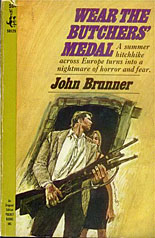REVIEWED BY DAVID VINEYARD:
JOHN BRUNNER – Wear the Butchers’ Medal. Pocket 50129, paperback original; 1st printing, May 1965. Film: How I Spent My Summer Vacation. Made for TV. Universal/NBC-TV; telecast 07 Jan 1967. Robert Wagner, Jill St. John, Peter Lawford, Lola Albright, Walter Pidgeon, Michael Ansara. Teleplay: Gene R. Kearney. Director: William Hale.

Before he became a major writer in the Science Fiction and Fantasy field with books such as The Sheep Look Up, The Complete Traveler in Black, and his masterwork, Stand on Zanzibar, John Brunner tried his hand at many genres, not the least the thriller, not surprising since thriller elements appear in many of his works, especially those with a near future setting. Wear the Butchers’ Medal appeared in this country first in 1965 as a Pocket Book original, with a nice Harry Bennett cover.
It opens with a brief note that the murder of a man selling guns to the Algerian FLN, who was found with a Swastika painted on the wall of a Gasthof near the body in Switzerland, inspired the book. It seems a bit strange that should make it pertinent now in the 21st century, but with the rise of European nationalism and Middle Eastern terrorism, it is.
Our hero is Phil Burns, an American student on a walking holiday in Europe, who accepts a ride to DÈ•sseldorf from a stranger at a gas station. Before he can think, he is offered a large sum of money by the man, Max Moritz, to deliver a wristwatch to his brother in England, and then as they pass a workman in the road flame shoots out, the car wrecks and his benefactor is dead.
There’s an attempt on Burns’ life in London, a macabre adventure in a German nightclub, and finally a quaint village in Bavaria where long buried secrets are rising to the surface, bearing strange fruit including a threat to the world at large.
Of course, there is a pretty girl, Angela, who is a Cypriot fleeing the trouble there who works in London for Moritz and his partner, good and bad men, not always who they seem to be, plenty of near misses, escapes, confusion, and all the other standard fare of the thriller, sub genus Nazi revival variety, are present. The writing is assured, the characters attractive or frightening as called for, and the descriptions of the countryside and settings masterful. The suspense is well maintained and the set-pieces all pay off, so there are no complaints.
It’s a solid well written thriller of the era made more interesting by who wrote it, modern European politics, and the film it inspired.
I reviewed How I Spent My Summer Vacation here earlier on this blog. I won’t go into it, save I was surprised to find it was based on a novel by John Brunner or that I missed that all these years.
Outside of the basic set up of an American student on a European vacation becoming involved in a budding fascist plot, there isn’t a lot of similarity between the rather dark novel and the much more lighthearted made for television movie. The hero of the novel is much more self-assured than the character played by Robert Wagner in the film.
If you like Brunner’s work, or the genre, the book is well worth reading. If not in the first rank of thrillers of the period, it shows where Brunner might have gone in another genre had we not lost him to science fiction, and, if you like the film, it is an interesting sidelight on that.
